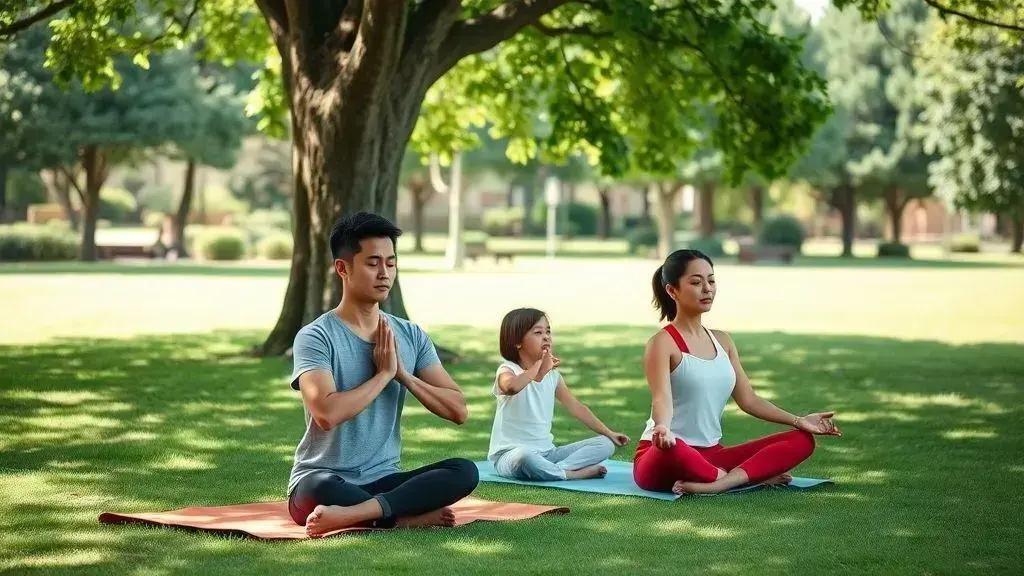Mindfulness for improving family relationships

Mindfulness for improving family relationships enhances communication and empathy, fostering a supportive environment where family members feel understood and connected.
Mindfulness for improving family relationships is more than a concept—it’s a way to cultivate deeper connections. Have you ever noticed how a moment of presence can change a conversation? Let’s explore how mindful habits can transform interactions in your family.
Understanding mindfulness and its impact on families
Understanding mindfulness is essential for enhancing family dynamics. It involves being present and fully engaging with one another. By practicing mindfulness, families can improve their communication and emotional connections. This approach encourages respect, patience, and understanding among family members.
The Basics of Mindfulness
Mindfulness teaches us to observe our thoughts and feelings without judgment. It helps create a calm environment where family members feel safe to express themselves. When everyone in the family embraces mindfulness, the atmosphere can become more harmonious.
Key Benefits of Mindfulness in Families
- Improved Communication: Mindfulness encourages listening and thoughtful responses, reducing misunderstandings.
- Enhanced Emotional Awareness: Family members become more aware of their emotions and those of others, promoting empathy.
- Stress Reduction: Practicing mindfulness can lower stress levels, leading to a more relaxed family environment.
- Conflict Resolution: Mindful families are better equipped to handle disagreements peacefully.
Engaging in mindfulness practices as a family can take various forms. Simple activities like shared meals, nature walks, or meditation sessions can foster connection. By participating in these moments, families can strengthen their bonds.
Mindfulness also teaches resilience. When faced with challenges, families that practice being present together can navigate difficulties more effectively. They learn to support one another through ups and downs while maintaining a sense of tranquility.
Incorporating mindfulness into family routines can lead to lasting positive changes. Creating a mindfulness ritual, like a weekly family check-in, can encourage open dialogue and deeper understanding. This practice can turn stressful moments into opportunities for connection.
Practical mindfulness techniques for everyday life

Practical mindfulness techniques can make a significant difference in everyday life. These techniques help individuals and families to stay grounded and present, leading to better relationships and emotional health. Simple methods can easily be woven into daily routines.
Mindful Breathing
One effective technique is mindful breathing. Take a few moments each day to focus on your breath. Inhale deeply through your nose, hold for a few seconds, and exhale slowly through your mouth. This practice not only calms the mind but also brings clarity.
Gratitude Journaling
Another technique is gratitude journaling. Spend a few minutes each day writing down three things you are thankful for. This practice shifts your focus from what’s lacking to appreciating what you have, enhancing your overall mood.
- Choose a quiet spot: Find a comfortable space to write without distractions.
- Be specific: Detail why you are grateful for each item.
- Make it a habit: Set a specific time daily to write in your journal.
Incorporating mindfulness into daily activities can also be beneficial. For example, while eating, take a moment to appreciate the flavors and textures of your food. Chewing slowly and savoring each bite can transform mealtime into a mindful experience.
Another approach is to create mindful movement. Activities such as yoga or walking in nature can enhance your connection with the present moment. These practices encourage awareness of your body and surroundings, allowing you to truly experience your environment.
Consider implementing family mindfulness activities, such as group meditations or nature outings. These shared experiences can strengthen family bonds while promoting a mindful lifestyle. Encouraging each family member to share their thoughts can create deeper connections.
The role of communication in mindfulness practices
The role of communication in mindfulness practices is vital for fostering understanding and connection in families. When family members practice mindful communication, they are more likely to feel heard and valued. This approach can change the way family members express their feelings and needs.
Active Listening
Active listening is a crucial skill in mindful communication. It involves fully concentrating on what someone is saying rather than just hearing their words. When you listen actively, you show respect and understanding, allowing for deeper connections.
Nonverbal Communication
Nonverbal cues also play a significant role. Body language, facial expressions, and tone of voice can convey emotions just as strongly as words. Being aware of these signals can help family members respond better to each other. Mindful communication includes being conscious of both what you say and how you say it.
- Maintain eye contact: This shows that you are engaged and attentive.
- Use open body language: This helps create a welcoming atmosphere for dialogue.
- Be aware of your tone: Ensure it reflects the feelings you want to convey.
Moreover, it’s essential to express feelings openly and honestly. Sharing thoughts and emotions encourages vulnerability and trust among family members. Using “I” statements can help communicate feelings without placing blame, making discussions more constructive and less confrontational.
Mindfulness also means being present in conversations. This allows families to focus on each other rather than distractions like phones or television. Putting away devices during family discussions fosters deeper connections and promotes a more meaningful exchange.
Practicing mindfulness in communication can lead to less conflict and more understanding. When family members feel safe expressing their thoughts, they can resolve disagreements peacefully rather than letting them escalate. This approach shifts the focus from winning arguments to finding common ground.
Building empathy through mindful interactions

Building empathy through mindful interactions is crucial for strengthening family relationships. When family members engage mindfully, they can better understand each other’s perspectives and feelings. Empathy leads to a deeper emotional connection and promotes harmony within the family.
Understanding Perspectives
One way to build empathy is by actively trying to understand others’ feelings. When someone shares their experience, listen attentively. Reflect on what they say and ask questions for clarification. This shows that you truly care about their feelings.
Practicing Compassion
Compassion is essential in fostering empathy. When someone is going through a tough time, show kindness and support. Let them know you are there for them without judgment. This compassionate approach helps family members feel valued and understood, creating a safe space for sharing.
- Offer emotional support: Make time to listen without distraction.
- Validate feelings: Acknowledge emotions, even if you don’t fully understand them.
- Share your own experiences: Relating your feelings can help others feel less alone.
Additionally, participating in activities that focus on teamwork can enhance empathy. Working together as a family on a project can teach members to appreciate one another’s strengths. This shared experience encourages open communication and strengthens bonds.
Engaging in role-playing exercises can also nurture empathy. Encourage family members to step into each other’s shoes. This practice helps everyone see situations from different perspectives and promotes understanding. Consider discussing how each role feels and what challenges they face.
Encouraging a culture of open dialogue enhances empathy. Create an environment where everyone feels comfortable expressing their thoughts and feelings. When family members know they can speak freely, they are more likely to share, leading to greater understanding.
FAQ – Questions About Mindfulness for Improving Family Relationships
What is mindfulness in family interactions?
Mindfulness in family interactions means being present and fully engaged in conversations and activities, promoting better understanding and connection.
How can communication improve family relationships?
Effective communication helps family members express their feelings and thoughts openly, reducing misunderstandings and fostering empathy.
What are some practical techniques for practicing mindfulness at home?
Some techniques include mindful breathing, gratitude journaling, and engaging in family activities that promote teamwork and empathy.
Why is empathy important in family relationships?
Empathy helps family members understand each other’s perspectives and emotions, leading to deeper emotional connections and a supportive home environment.





